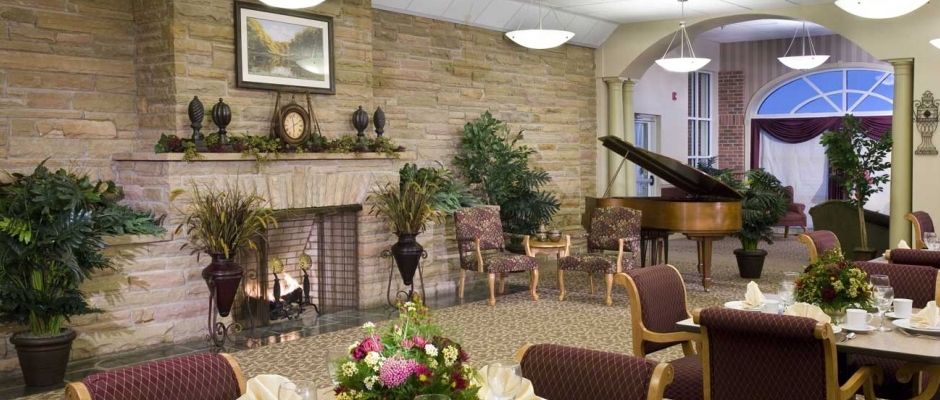For many decades, the model for facilities offering senior care — particularly for people living with dementia — was what you might call “hospital light.” The facilities felt more or less like hospitals, without the more intensive levels of medical care. Today, we know a lot more about caring for older adults, and we also know that dementia, in varying degrees, will be a part of aging for many millions of seniors. Most importantly, we know that people with dementia don’t need to live in a hospital, or in any kind of institution. More than that, they do need to be in an environment that feels as homelike as possible, while still providing for the safety and care that people with dementia need.
Mather Architects has been working for many years with nursing homes, assisted living facilities and other organizations to create spaces that balance safety and medical support with homelike, familiar environments for people living with dementia or other memory impairments. We’ve learned a great deal about what architectural design can do to achieve that balance — and my experience of caring for my own father has shed some personal light on our professional experiences. Between the two, I’ve developed some principles that embody how thoughtful architectural design can make an enormous difference in the quality of life for people living with dementia.
1. Maximize awareness and orientation. Possibly the single most important principle is to use design to make the facility, and its individual rooms, as easy as possible to navigate and for residents to understand where they are in the facility. Use very simple signage that features direct and simple symbols. For doors residents shouldn’t use or places they should not go, don’t rely on locked doors and alarms; as much as possible, make it easiest to see the routes residents should take and harder to see the routes they shouldn’t. (For instance, locate a locked exit door parallel to the hallway rather than at the hallway’s end, where it will be visible the length of the corridor.)
Create purpose-specific rooms, so that a resident always goes to a given room only for a given activity, and vary their design and decor so that each room provides a distinctive aesthetic and spatial experience. This will allow residents to draw upon many different faculties and associations to understand where they are and why they are there, and minimize feelings of disorientation.
2. Carefully manage visual stimulation. Harsh lighting can be disorienting to people with dementia, so minimize glare by using carpeting, low-gloss floor finishes and sheer curtains, and make all lighting as even as possible. Eliminate any unnecessary glowing signs (i.e., exit signs usually must be illuminated, but the sign for the utility room need not be). Create spaces where non-ambulatory residents may have views of active outdoor or indoor areas. And make as much use as possible of natural light. Medical chronobiologists have found that our biorhythms are affected by our awareness of the natural cycle of the day, and that these rhythms can affect the severity of medical symptoms and the body’s response to medical treatments.
3. Allow for private spaces when possible. People with dementia are sometimes confused or disturbed by the actions of others. Private spaces, or at least private bedrooms, allow residents to have a place where their belongings are secure and where they can retreat from close proximity to others when necessary. Also, if the entrances to these private spaces can be personalized, it will allow the residents to find them more easily, thus feeling more secure and independent.
4. Carefully manage acoustic stimulation. Care facilities of any kind can be very noisy places, full of jarring sounds, if care is not taken to prevent it. Designers of homes for people with dementia should take care to eliminate public address and other facility-wide audio systems, and to either locate rooms with noisy equipment distant from residential areas or to insulate these rooms for sound. There should also be a few private bedrooms that have extra soundproofing, for use by residents with disruptive vocalizations. Activity rooms and public areas need not be soundproofed, but should be furnished with sound-absorbing materials, and activity rooms should be capable of being closed off, particularly if they involve the use of televisions or other media.
At the same time, however, thought should be given to places and ways that residents can enjoy music. For many people with dementia, the last area of the brain that processes the world normally is the area devoted to music. This was the case with my own father. He had always enjoyed music, particularly the classical greats: Handel, Bach and Beethoven. We would find a place on the porch where we could watch the trees and sky, enjoy a pleasant breeze, and listen to the music that had always given my father such pleasure. At these times, I could see the joy and the connection on his face.
The example of music speaks to the larger principle that underlies all of these more specific design principles: many people living with dementia still retain much mental capacity and many abilities. They have some capacity for independence, for physical exercise, for communication, for meaningful activities and for connection with others. The most important service that architectural design can render is to help them exercise their remaining capacities as much as possible, for as long as possible, while keeping them safe and well-oriented. If we do this, we’ll be helping people with dementia and their families to find some peace, happiness and enjoyment at the end of life.

